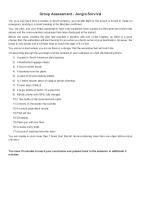Study Case Outsourcing Reda Ouchain [PDF]
FRIEDLAND TIMBERS CASE STUDY DONE BY REDA OUCHAIN CASE STUDY QUESTIONS: 1. Why do all the logistics costs seem to be
32 0 183KB
Papiere empfehlen
![Study Case Outsourcing Reda Ouchain [PDF]](https://vdoc.tips/img/200x200/study-case-outsourcing-reda-ouchain.jpg)
- Author / Uploaded
- Reda Ouchain
Datei wird geladen, bitte warten...
Zitiervorschau
FRIEDLAND TIMBERS CASE STUDY
DONE BY REDA OUCHAIN
CASE STUDY QUESTIONS: 1. Why do all the logistics costs seem to be rising at the same time? An operational forecast aims to make statements about future demand in the right level of detail such that it can drive the production and distribution planning and the inventory levels in the supply chain. Talking about the supply chain term which is a set of links between actors, that produces complex connections in the chain . If your forecast is too high you will produce more than the demand. Your finished goods stock will build up, and in the longer term, warehousing costs may start to rise. Besides the stock increase, your people and machines will be deployed in producing more than required. Capacity is misused, productivity drops, and from there your operating costs start to go in the wrong direction. If your forecast is too low, your production will not satisfy the demand. Sometimes, this can still be covered by safety stocks. But safety stock costs money as well! If safety stocks cannot make up for the production deficit, you’ll end up with out-of-stocks and expedited or late deliveries. And there you go with your freight costs rising and your service levels dropping. 2. What do you think are the basic problems in Friedland? The basic problems or the major dilemma is really the lack of synergy and collaboration between all the actors or the multi actors’ network. Lack of information transmission shown its havoc. Every function or department working in isolation. Ordering materials not knowing real time state of stocks level. Some of the basic problems too is sticking to core suppliers instead of having a multi network for urgencies like this. Even the purchasing department, who do not order the amounts that they request.’
3. What would you recommend Johann do? Because a better forecast leads to lower operating costs, lower stock levels, and higher service levels. But how do you make sure you have a good forecast? How can you improve it? Forecasting is a business function. Every business function needs a clear process definition. The forecasting process needs to be embedded in your organization with clearly defined roles and responsibilities. Do you need a centralized organization? Someone needs to be accountable for that forecast in the company.Then comes the more tangible part. Data. You need to store data, harmonize it, interpret it, and know how to use it to your forecast’s advantage. Tool is necessary to use that data and get a forecast out of the fit. Of course, you don’t necessarily need the most complex tool on the market. I would recommend Johann to re-engineer the whole supply chain process. And introduce a leaner philosophy.In this case , we testified the supplier late delivery that shows a rough supplier relationship. Implementing supplier relationship management (SRM) which is a systematic approach of assessing suppliers' contributions and influence on success, SRM is used by supply chain professionals involved in areas such as procurement.The all time ideal is implementing a JIT way of manufacturing and purchasing. I can present a multitude of systems but the most important thing that Johann will have to accomplish, is embedding a mindset of continuous improvement and passing it to his partners mainly called suppliers in this case. For a conclusion integrating the share of the information flow ,sharing the real life data ,to escape the bullwhip effect that disrupt the working flow of the company.Especially with a multitude of actors in the chain the complexity rises linearly. This solution is suitable for the budget Johann is left with.
DISCUSSION QUESTIONS: 1. What do you think are the main factors that encourage logistics to change? Yes, in the modern day, there is a huge changing for logistics. There is a lot of evidence that supports this view. The evolution of logistics has been characterized by an increasing degree of integration, for example. In the past few years ago technology has revolutionized these communications. The Main factors are : technological disruption , customers becoming more knowledgeable.Demanding higher quality, lower costs and better service.Competition is getting fiercer, and organizations must look at every opportunity to remain competitive.There is changing power in the supply chain. Very large retail chain demand customized logistics from their suppliers.The awareness of corporations rises towards the respect of the environment like by the exploitation of renewable energy and the reduction of the industrial waste . 2. When Christopher says that ‘supply chains compete, not companies’ what exactly does he mean? With considering that the supply chain is the nervous system of the whole company.The conventional wisdom is that the competition in future is about SC vs SC. No company in today’s world could make it on their own. But technically SC vs SC is not accurate as it seems to a lot. To it to be reliable a company shouldn't buy from the same suppliers that sold to their competitors.As an example of how often that happen, if you look at the SC of Colgate,Unilever,P&G,9 out of 10 they are buying from the same suppliers, and selling to the same customers, it’s not a team vs B team it’s all about relationship management. Who can manage his Relationships well going to win over the competition.









